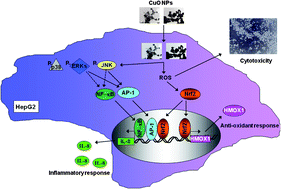Copper(ii) oxidenanoparticles penetrate into HepG2 cells, exert cytotoxicity via oxidative stress and induce pro-inflammatory response†
Abstract
The potential toxic effects of two types of

* Corresponding authors
a
URBC, Namur Nanosafety Center (NNC), Namur Research Institute for Life Sciences (NARILIS), University of Namur (FUNDP), 61 rue de Bruxelles, B-5000 Namur, Belgium
E-mail:
jppiret@fundp.ac.be, olivier.toussaint@fundp.ac.be
Fax: +32 81 72 41 35
Tel: +32 81 72 41 32
b
Department of Science and Analysis of Materials, Centre de Recherche Public – Gabriel Lippmann, 41 rue du Brill, L-4422 Belvaux, Luxembourg
Tel: +352 47 02 61 521
c
Physics of Matter and Radiation (PMR-LARN), NNC-NARILIS, University of Namur (FUNDP), 61 rue de Bruxelles, B-5000 Namur, Belgium
Fax: +32 81 72 54 74
Tel: +32 81 72 54 81
The potential toxic effects of two types of

 Please wait while we load your content...
Something went wrong. Try again?
Please wait while we load your content...
Something went wrong. Try again?
J. Piret, D. Jacques, J. Audinot, J. Mejia, E. Boilan, F. Noël, M. Fransolet, C. Demazy, S. Lucas, C. Saout and O. Toussaint, Nanoscale, 2012, 4, 7168 DOI: 10.1039/C2NR31785K
To request permission to reproduce material from this article, please go to the Copyright Clearance Center request page.
If you are an author contributing to an RSC publication, you do not need to request permission provided correct acknowledgement is given.
If you are the author of this article, you do not need to request permission to reproduce figures and diagrams provided correct acknowledgement is given. If you want to reproduce the whole article in a third-party publication (excluding your thesis/dissertation for which permission is not required) please go to the Copyright Clearance Center request page.
Read more about how to correctly acknowledge RSC content.
 Fetching data from CrossRef.
Fetching data from CrossRef.
This may take some time to load.
Loading related content
